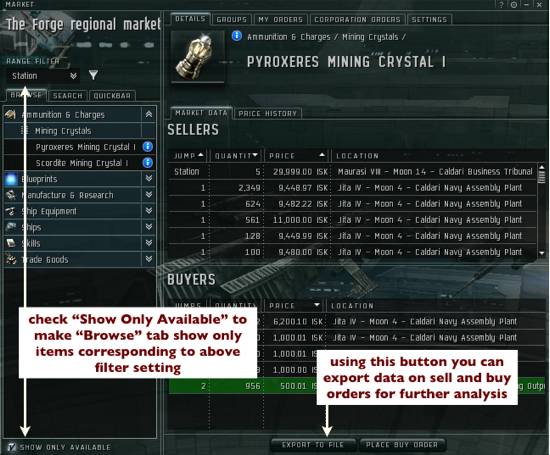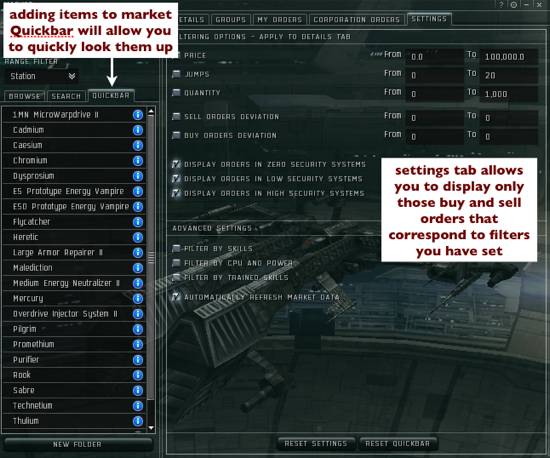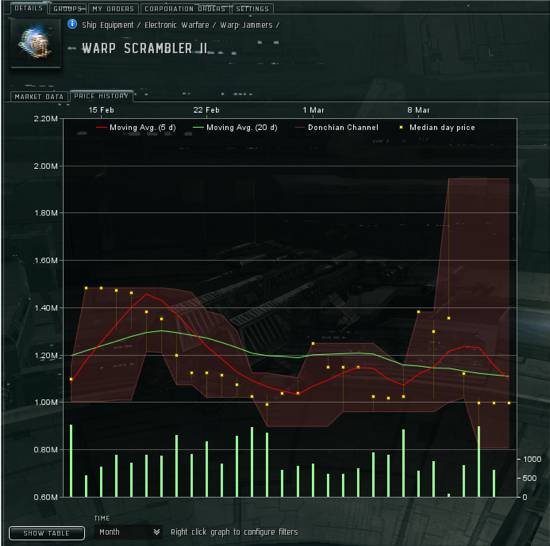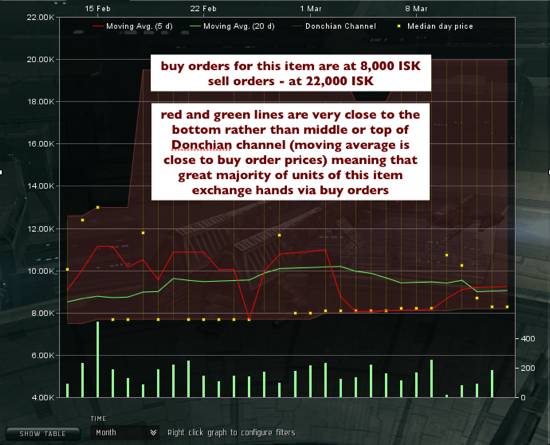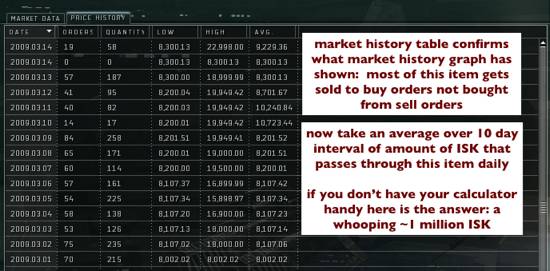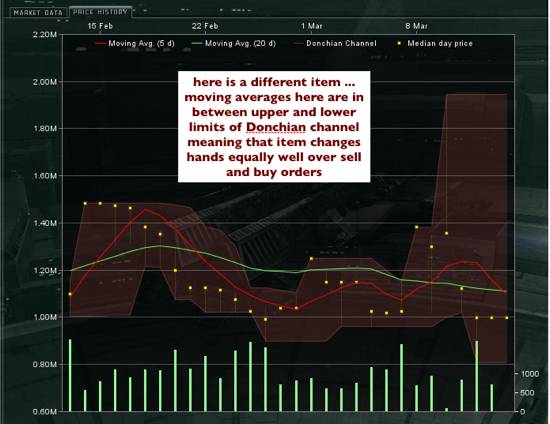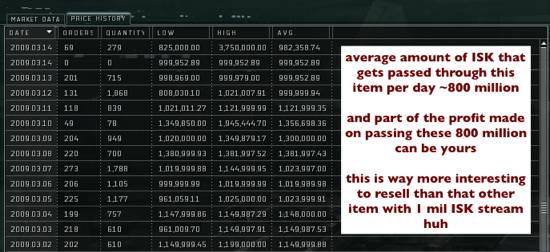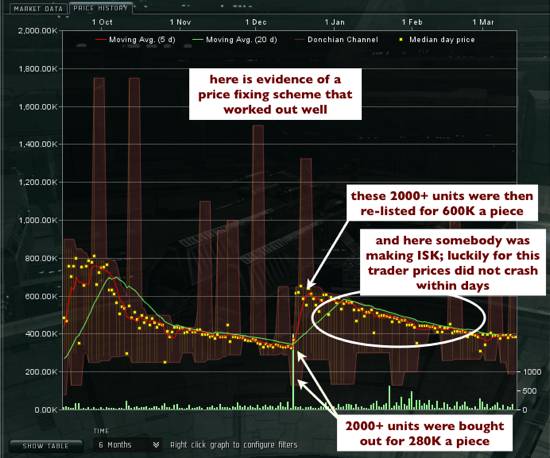The Basics of Trading
"What is best way to trade? Buy low and sell high, of course!" - Anonymous Trader
"Every [trader] needs to master three essential components of trading; a sound individual psychology, a logical trading system, and good money management" - A. Elder
Contents
Introduction: Why Trade?
Trading is one of the highest income activities in EVE. All ISK-making activities in EVE naturally have a cap on their hourly income. For activities involving harvesting game's resources, such as NPCing and mining, this cap is typically somewhere in the range of 10-30 million ISK per hour. Trading obviously has its own limit, as you cannot generate unlimited ISK/hour, however it does offer a much higher cap per same time and effort invested when compared to other ISK-generating activities the game has to offer. It does not require a lot of actual online time and you are free to log in whenever you wish. It can be made as risky or low risk as you would like it to be. And what's more, trading generates ISK even when you are not playing the game. You can be gone on vacation for a week and ISK will be slowly seeping into your wallet.
Given the above, why doesn't everybody in EVE trade then? The answer is simple: not all players find it fun, not all players become successful at it, not everyone can set it up to make more income than they can generate from PVE in this game. Being a successful trader who finds trading to be continuously engaging and interesting requires a certain mindset. Some players might find mining relaxing, while others find it excruciatingly boring and frustrating, and similarly not everyone enjoys trading. As you start experimenting with it, keep in mind that it is only a good way of generating ISK for as long as you're having fun doing it.
"Buy Low, Sell High"
Every beginning trader seeking advice on how to trade the best will eventually encounter a response that goes something like "buy low, sell high". However, this response only springs more questions to mind. Buy what? Sell where? What is low? And what is high?
Amateur traders may seek answers to these questions from their friends, corpmates, or post make threads in market forums. My advice: don't. It is highly unlikely that a successful trader will reveal their trading secrets to you, ultimately turning you into a competitor. Unlike mining, running missions, maintaining a POS network, exploration, or ratting in 0.0 space, trading offers very little incentives for group play. As such, the mindset of a regular trader is that everyone swims through the murky waters of market on his or her own. In summary, it is highly unlikely that anyone will tell you exactly what to buy, and where, and how you can make profit on it.
If you would like to find some worthwhile opportunities to make ISK trading, you have do the homework yourself. There is no easy way about this that would simply trigger an ISK shower. Spend a few hours doing market research and reading guides posted on the subject on the main EVE Online market forum. The actual process of buying, selling, and hauling goods is not very difficult. It the art of being able to quickly see opportunities to buy/sell at a good profit that you have to master.
How Can I Start Trading?
There are only two prerequisites to trading:
- A investment sum.
In general, 100 mil ISK is a sufficient amount to get you started. In trade, money makes money. The more available capital you have to invest, the more profit you have the potential to make. Most traders get this initial investment capital from other ISK-making activities such as running missions or belt ratting.
- A character with at least 30 open buy/sell orders.
DO NOT train your combat main to do this carebear task. Otherwise you'll be clone jumping to empire several time a week to update orders, which means you will be out of gangs and out of pvp. If corporation gets a war declaration your main will also not be able to do any hauling tasks that might be required for your trading. Instead, roll another character on your account, give it plenty of Charisma, Memory, and Willpower, then plug in the following skills:
- Trade: +4 open buy/sell orders per level
- Retail: +8 open buy/sell orders per level
- Accounting: -10% to transaction tax per level
- Broker Relations: -5% to broker fees per level
- Contracting: +4 open contracts per level
Spend about a week training Trade IV, Retail IV, Accounting III, Broker Relations III, Contracting I and may be II-III levels on optional skills and your alt will be set to make you ISK for the rest of the year. Optional skills:
- Marketing: allows to sell items remotely, each level extends range at which you can sell items
- Daytrading: allows to modify orders remotely, each level extends range at which you can alter orders
- Procurement: allows to set up buy orders remotely, each level extends range at which you can place orders
- Visibility: extends effective range of remote buy orders (for local buy order you can set whatever range you wish from station to region-wide)
- Margin Trading: each level of skill reduces the percentage of ISK placed in market escrow when entering buy orders
- Wholesale: + 16 open buy/sell orders per level, requires Retail V
- Tycoon: + 32 open buy/sell orders per level, required Wholesale V
- Hauler skills: Racial Frigate III, Spaceship Command III, Industrial II, Hull Upgrades II, Shield Upgrades I
Once you have fulfilled both of these prerequisites, think of Nike's slogan Just do it. The best way to learn something is by experience. This is true for pvp and it is true for trading. Do a bit of homework then just start experimenting. Eventually you will see certain patterns and figure out what makes you the most ISK.
What can I trade?
Practically anything can be bought at a low price and resold at higher value, but your play time is limited and you have to pick what exactly it is you want to be trading. Several considerations have to go into this. How often do you plan to come online and change orders? Obviously trading in Warp Disruptor II's you will be often outbid while if you trade in Magnetic Plating II you will not have to modify your order so often. Do you want to devote any time to hauling? If so you might look into trading items that fetch a good price in another region. Do you want to make a lot of ISK in the shortest amount of time? Well of course you do! But so does every trader out there competing with you.
Here are some common ways to trade:
- Trading NPC goods. This is the most basic method of trading that many newbies start out with. NPC trade goods sell in the "Trade Goods" section of the market. NPCs set up sell orders and buy orders for these at certain price differences that can be exploited to make profit. The down side of this type of trading is that it requires hauling stuff often between two different regions, which is time consuming. The price difference also slowly decreases as more and more players start using the route. Eventually it gets extinguished and those who have been using it have to find a new ones to continue making ISK. In empire this activity is very low pay generating at most may be 10 million ISK per hour. However the more risky the route is, the more profitable it can be: Making 2.2 Bil ISK a Day via NPC Route
- Trading modules. If you have ever lived in a region where NPCs do not drop the racial items needed to fit out your ships this way of trading is quite apparent. While T1 non-named and T2 modules can be produced anywhere, named items are lacking in regions where NPCs don't drop them as loot. Their entire supply in these regions comes from traders importing them in and reselling them at a markup. You can also trade T1 and T2 modules between two trade hubs if you see there is a good discrepancy in prices. There are can be decent profits to be made if you haul your items to places where little or limited manufacturing takes place, such as lowsec or 0.0 stations. Modules can be successfully traded via buy/sell orders as well as private bulk orders from producers and inventors.
- Trading ships. Ships can be produced anywhere on site just like T1 non-named and T2 modules. Unlike modules, however, ships require significant investment in ISK, as one T1 cruiser hull already costs 4-6 million ISK on its own. Also unlike modules ships are rarely dropped to buy orders. Players prefer to blow them up either in PVP or in attempts to get their insurance payout. Ships are therefore best traded by establishing contacts with the producers who often don't want to bother with hauling them to trade hubs and then sitting there watching sell orders. For this you would need to own a freighter. In-station trading in ships is not very profitable for investments required. Exceptions to this rule are of course events that change a ship spec, for example when assault frigates were boosted they significantly went up in price. Anyone who stocked up on them for cheap could resell them as a very good markup after the patch day.
- Trading building materials. Building materials include things like common minerals and ores (tritanium, kernite, zydrine, etc.), raw moon materials and products of complex and simple reactions, capital ship construction components, blueprint originals and blueprint copies needed for the said production to happen, and invention-related materials such as datacores needed to generate T2 blueprints. If you would like to trade in building materials make sure you understand what they are used for.
- Trading finished/built goods. Purchase BPCs + materials for a cheaper price than the finished product gets sold for and thus make ISK on building and selling it. BPCs can be purchased over contracts as well as the sell order forum. Some items, such as Cosmos and storyline items, require certain skills to build which few characters in game possess. Thus you can often find deals on these kinds of BPCs that their owners have obtained form some plex or exploration site but have no skills to produce themselves. Other items that can be traded in this way are faction ships, faction items, and faction POSes.
- Reprocessing. This is a very common tactic used by many players with industrial background. Simply purchase low meta cheap rat loot for less than the cost of minerals you can reprocess it into. Then reprocess these items and sell off the minerals at profit.
- Trading POS fuel. EVE universe is hopelessly littered with POSes and each hour every single one of them consumes fuel. Those players who have no time or means to go to a major trade hub to purchase POS fuel will often pay a nice markup to have it readily available in vicinity. POS fuel gets consumed especially fast in places where territorial wars take place and POSs get killed on daily basis. In addition, each region features ice that can be refined into fuel that can fuel towers of the race that holds sovereignty in that space. So for example if you have a Gallente tower in Amarr space you won't be able to mine local ice belt for fuel. All local ice would refine into helium isotopes such that you would have to buy imported and marked-up oxygen isotopes.
- Trading implants, rigs, skill books, blueprints, GTCs, etc. Just like modules all of these items can be bought and resold at a higher prices in places where they are lacking and demand is high. There is a decent demand on rigs, implants, and skill books in 0.0 space. Blueprints originals and copies can be resold on contract system just like any other item.
- Trading via Sell Orders Forum. Anything being bought/sold over Sell Orders forum can be traded for a profit; sometimes some exceptionally good deals can be found there. The trick is being able to sift through all the information in the shortest period of time. It is usually the more experienced and advanced traders who know their prices who benefit from using this forum the most. Amateur traders can get quite lost among all the threads posted there.
- Trading through contracts. Contracts have replaced old escrow system in Revelations expansion. This system is an alternative system used for selling and buying items that cannot be sold on regular market, such as rigged ships, blueprint copies and researched originals, Cosmos, faction, and officer loot, and various items such as Apotheosis shuttles and snow ball launchers. Just like on regular market, there are certainly good deal that can be found on contracts. In general, however, contracts trade requires considerable investment because items sold over it are not cheap.
- Trading characters. Unlike other ways of trading this one requires input of real life money. When you sell a character, you have to pay 20 in fees in order to transfer it from one account to another. However, it is not much of an obstacle for those players who already sell game time codes for their ISK. With character trading it is possible for example to resell a char for 1 billion ISK profit thus paying just 20 for 1 billion ISK.
- Keep in mind that anything in EVE that has an ISK value can be traded for profit. If it is not listed here it does not mean that you cannot buy and resell it for more ISK.
Where to Trade
There are many locations where you can do the "buy low, sell high" trick. The best way of learning pros and cons of each location is by experimenting.
- In-Station Trading. Perhaps one of the most common and laziest ways of trading. Using this approach, you don't have to undock or haul anything - just set up buy orders in the station where you are docked. Once goods drop, resell them for a profit.
- Intra-Regional Trading. Trading within a region can be accomplished by setting up region-wide buy orders. Once a month, items dropped to these buy order can be picked up and sold for profit at the main trading hub in region. You can do the hauling yourself, or alternatively outsource it via courier contracts to other players.
- Inter-Hub Trading. Trading hubs are systems with large populations of players who consume goods from the market at a decent rate. Such systems can be mission running or factional warfare centers, or a populated 0.0 system. Most regions have one or more trading hubs and there is usually a price disparity between them such that goods can be traded between for a profit.
- Inter-Regional Trading. Each region offers some resources that other regions do not offer. The demand for these resources in those other regions fuels inter-regional trade. For example, you can buy hybrid weapons cheaper in Gallente space where rats drop them and resell them for more in Amarr space where rats drop only lasers. Common items to trade in this way include named modules, faction ammo, and pirate implants.
- Inter-Sec Trading. This is trade done between two systems of different security status, such as trading between highsec empire trading hub and a lowsec or nullsec system. In general, inhabitants of 0.0 and lowsec do not want to come out to highsec to shop as this is accompanied with a certain measure of risk and it also takes them out of pvp gangs. Thus they will pay more to buy goods locally. This is especially true of 0.0 alliances that have several wardecs and that do not have good industrial backbone.
- Forum trading. Trading can be done completely over sall and buy orders forums in which case you'd just have to log into the game to complete the actual trade.
Tracking Income
As a trader, your income is ultimately your measure of success, but it is not just income that you have to consider. It is income per time you spent earning it. The income figure itself is pretty meaningless. Which of the two players do you think is more successful at trading: trader A who spent 3 years earning 8 billion ISK or player B who spend one month making 450 million ISK? Obviously the trader who has spent one month making 450 million ISK because his income/time is greater (450 mil per month) even though the trader with 8 bil in his wallet is overall richer (222 mil per month).
One of the greatest mistakes people make when trading is concentrating purely on the profit part and forgetting to consider time and effort put in. Say you have a module that you can purchase at 800K ISK and resell at rate of 100 units of per day at 880K (10% profit) in same station. Alternatively you can spend 7-8 minutes hauling these modules 15 jumps elsewhere and sell them there for 2x the original price but only 10 units of it will sell per day at this other location. 100 units selling at 80K profit and 10 units selling at 800K profit will each generate you 8 million ISK of profit per day. In the second case, however, you will spend 7-8 minutes hauling and lose time. A lot of players when faced with similar choice often pick the one that seems to generate most profit and forget to evaluate the time component. As a result they get stuck performing extra grind. A successful trader will always aim to optimize time that he or she spends generating profits.
When you're thinking of ways to optimize your time trading, note that volume plays an important role here. Obviously the faster you can resell items, the greater your profit/ time will be. When you are looking through items to trade remember that your success in trading is not a simple function of difference between buy and sell orders. An item with lesser price discrepancy but greater volume traded each day has the potential to make you more ISK than an items with bigger discrepancy but lower trade volume. On the downside, high volume items also attract a lot of competition so you may be stuck having to bump your order more often (meaning the time component goes up). Traders who have less time to devote to trading will thus sometime opt out to trade lower volume less profitable items.
Since income is direct measure of your success as a trader, many traders run 3rd party programs and compile their own spreadsheets to trace how much they are making. They analyze each item one by one to see how profitable it is and how much ISK/time it will add to their wallet. How technical you want to get here and how much time you would like to spend on this is completely up to you. A professional trader who plays EVE as a trading MMO game will spend quite a bit of his or her gaming hours at this activity. However it is not necessary to be running a bunch of spreadsheets and programs to make decent ISK via trading. I personally have not made much use of any 3rd party programs and simply relied on my intuition to tell me what's making me ISK and what isn't.
Here is a list of some of this software created by other players to help others in their capitalistic endeavors. Some of it is free to download, some isn't. Most of it requires your FULL character API key so make certain that you know what that means before you plug it in.
- EMMA - does a lot of things ... was free but now i think it comes at 100 mil ISK fee
- EVE-Tycoon - lets you help optimize the profit you can get from your orders
- EVETycoon - mainly deals with mineral market, refining and reprocessing
- EVE-Income - allows you to see rate at which items sell, major buyers, trade efficiency, and a few other things
- Market Master - software that tells you which of your orders have been outbid and need checking, not free
- MarketMuch - another program that analyzes what orders need to be updated, also not free
- NavBot - trade route finder
- Offline Wallet - wallet and transaction manager that can be used offline
- EVE Commander - another offline wallet managers
Market Window
Market window has several filters available as well as quick reference bar that will make it easier to you to look up market information. You can also export information on buy and sell orders within the region for any one item.
Analyzing Market Graphs
You have a limited number of buy/sell orders, perhaps a few hundred million of investment money, and a few hours of time that you can spend on trading each week. When doing market research, your priority is to find items that will make you the most profit per your limited time and resources. You can use software to import buy/sell order files and analyze them for you. Alternatively you can also do it by eye and use some basic math skills and your intuition to guide you.
In this task you will find the market history graph and tables are of great help. After all what better predictor is there of future behavior of certain items sold on market than evidence of their past behavior. I will go over a few basic examples and things you need to pay attention to when analyzing market history.
Here is a typical market history graph.
On it you can see several things:
- Moving averages. These are denoted by green and red lines.
- Donchian channel. This channel shows you the highest and lowest selling prices of an item withing the past 7 days - it holds the max and min for that time.
- Median price. Average is not always a good measure of price of an average item because it can be significantly influenced by outliers (items being sold or bought for very high or low prices), in which case median is a much better measure of the "average price". Median shows you the price of an item sold right in the middle of the entire volume sold per day, so if 123 units get sold medium would be price of 62nd unit.
- Volume. The small cyan bars at the bottom of the graph represent volume being sold with the actual volume axis being denoted on right hand side.
- Price. The left hand side y-axis shows the price of items being sold
- Time period. At the very bottom of the graph you can change the period of time for which you would like to see the graph.
You can also switch the graph to show you the price history table that contains the actual numbers that have been plugged in to create it.
Below is market history graph for our first item. Buy order for it stand at 8K ISK and sell orders stand at 22K ISK. Now if you switch over to its market history graph there are a few things you can observe. First thing that come to mind is that the moving averages are very close to the bottom of the Donchian channel. When the average is close to buy order price this means that most units that change hands do so by being dropped into buy orders rather than being bought over sell orders. The volume bars average out at approximately 250 units. So you will have no problem buying this item, but not a lot of it ends up back as sell orders.
What can be the reason for people buying out large volumes of this item and not reselling? The item is obviously getting consumed somehow. One way items get consumed is in pvp, but this is a crappy warp scrambler so it is unlikely to have such a good demand. Another explanation is that it is simply being reprocessed into minerals. For some items the combined sell price of minerals it reprocesses into is greater than the cost of the item itself. This would give us the pattern observed on the above graph.
Next lets use market history table to calculate profit that can be made from this item. This is done very simply by multiplying volume sold per day by average price. Sum this up for each day then take an average by dividing your sum by number of days.
Lets take a look at another item now. Below is a market history graph showing sine wave-like moving averages. For the most part these averages are somewhere in the middle of Donchian channel. Average volume sold per day is close to 1000 units.
Now lets calculate the amount of ISK that exchanges hands through this item every day.
Price Fixing
In a price fixing scheme, you temporarily gain monopoly of an item to dictate its price. To do this you buy out entire stock of the item and relist it for a higher price. After this you have a period of time ranging from a few days to a few weeks until the price crashes back to what it was and you stop making profit. You goal in this time is to make as much ISK as you can (and isn't is always with trading?).
When you are attempting to price fix an item, there are several things to keep in mind:
- The sell orders for your stock need to appear natural. Nothing alerts the buyer more that some sort of price fixing is going on like a mega-sell order for a nice round price. Create several sell orders for the item and underbid yourself each time by 0.01 ISK.
- You should not set up just sell orders but also buy orders for this item to make sure you are the only one buying it. Eventually resellers of this item will notice your scheme and try to take advantage of it. You want to cut off their supply in the mean time via buy orders.
- Eventually producers/ratters will turn up on the market and set up their items for sale. Some of them will not for whatever reason take advantage of the scheme you set up and stubbornly list their stuff for original price. Buy it out and relist.
- Attempt to artificially raise buy order prices by fiercely competing with other buyers of this item. Hopefully a few of them will follow suite. Then when your price fixing scheme is coming to the end dump the remaining stock you have to their buy orders.
Price fixing schemes require a lot of attention for their duration. You will have to check your buy and sell orders several times a day, so obviously this is best done when you have a lot of free time to watch your orders. Naturally frequency of price fixing attempts rises around major holidays when people have more free time on their hands. These schemed are also risky enterprises. You can make a bil or two rather quickly, but you can also lose money on this sort of exercise.
Evidence of past price fixing schemes can be seen from market history graphs. If the scheme has just started, the graph might not yet have updated to reflect it. However you can simply compare average price of the item as shown on the graph to its price on sell orders. If the price is much higher it means the item might have just been price fixed or it is in very low supply. In any case, if you need to purchase it, it would be better to wait a few days for price to come down.
When you browse market graphs you will notice patterns alike the one pictured below:
Courier Contracts
One of the best ways to save yourself time is to oursource hauling jobs to somebody else. This way you are not spending your gaming time on jumping gates and risking getting suicide ganked. Of course you have to pay a fee for courier contract. It only makes sense to create them when the profit you will generate on items transported would cover this fee very well.
How do courier contracts work: Open up Contracts window and under "Available Contracts" tab switch the contract type to courier and click on "get contracts". This will allow you to see outstanding courier jobs. When a pilot accepts courier job, a plastic wrap package drops into his or her items at the starting point station. All of the items in courier job get packaged into this one plastic wrap container. The plastic wrap package has exact size of the items inside and can be up to 981,000 m3 in volume (thus you do not need to package your items into secure or freighter cans prior). At the time that the contract is accepted, collateral value is subtracted from pilot's wallet. This value is not deposited to the issuer's wallet until the moment that contract has been failed. The pilot who accepted the courier job will pick up plastic wrap at the starting location and make jumps towards end destination. There, he can bring the courier contract back up and click on "Complete" button. At this point the contents of plastic wrap will be spilled back into your hangar and he will receive his reward fee for the job as well as his collateral back. The pilot delivering your contract is also able to look inside the plastic wrap and inside any cans packaged in the plastic wrap to see the contents of courier package.
Failing courier contracts: Sometime you will come back to the game and see that your courier contract has been failed or is overdue. Most common reasons for failing courier contracts is when pilots get suicide ganked along the way. This can be the case if the value of the package exceeded a couple hundred million and pilot transporting your stuff was not careful enough. Cargo scanners penetrate inside a single layer of plastic wrap of courier packages without a problem. At any time the contract is outstanding, the pilot who is doing the hauling will have "Fail" option showing on it. Once they get suicide ganked most will click on "Fail" and also sometimes choose to drop you an evemail about it. Another reason courier contracts get failed is when you have underestimated the collateral value. Most pilots doing courier jobs will take a look inside your package to see what it is exactly that they are transporting. If they figure they can resell your stuff at a profit, guess what most of them will choose to do? Other way to fail a courier contract is to accidentally break the courier package. When you right-click over it, this brings up options to "look inside" or "break". Once courier package is broken up the courier job cannot be completed. Newbie pilots may accidentally do this. And the final reasons for failing courier jobs is simply them being overdue. On all couriers you will have to specify time frame in which the job has to be completed. If the job is not completed in this time, you will get an option to give extension of 24h and then fail the contract yourself if it is still not done. On rare occasion pilots doing your courier job may have real life problems or computer problems that will prevent them from completing the job on time. In this case you will be able to fail it once time is past due and receive the collateral for your items.
Fees: Courier fees range widely depending on start point and destination point of the courier job, size, collateral, and risk involved. Here are some general guidelines:
- Contracts that are less than 25,000 m3 in size can be transported by regular T1 hauler (iteron V) or a transport ship. These ships cost approximately 80-100 million ISK (1-3 mil for itty V) so quite a few player own them. Trasport ships and T1 haulers are also quite a bit faster than freighters in completing courier jobs. Prices of these contracts can thus be set lower than for courier jobs that require a freighter.
- Anything over 30,000 m3 in size would definitely require a freighter pilot to get hauled. Freighters cost 600-800 million ISK, so fewer players own them, and take around 40-50 seconds to align at each gate making transport with them be a rather tedious task. Thus freighter courier jobs demand a higher fee to get completed.
- If you are setting up a courier between two well-populated areas, there are greater chances that there will be other courier contracts up destined to the same area. Thus pilots who accept your contracts can also accept several others along the way. And since destination is another well-populated area the pilot can also grab a contract on the way back. Thus you can afford to pay lower fees for your contracts because courier pilots can thus compensate for it accepting other contracts along the way. However, if your courier job requires the pilot to jump 20+ jumps to the edge of empire space to some forsaken system where nobody lives, you will have to pay more for such a job.
- If the collateral on the job is less than 100 million than chances are that most players who have played the game for at leas 2-3 months will be able to run it. Collaterals of 100 mil up to 500 milion can be accepted by majority of EVE's population as well. Collaterals approaching 1 billion ISK and over that amount will usually have to wait around longer. Fewer players have this kind of ISK. When the pilot accepts a courier contract the collateral gets subtracted from his wallet immediately, meaning that the more he pays, the less other contracts he would be able to grab alongside with yours because he will simply run out of ISK. Thus couriers with higher collateral value also need higher fee.
- Contracts to lowsec and 0.0 space quite obviously demand a higher fee because they entail greater risk. Jump freighter pilots would typically charge 10-30 million ISK per jump into 0.0 space. Smaller volume items can usually hitch a transport for around 10 mil. When making couriers in or out of lowsec or 0.0 space it is best to keep volumes small. Few people want to take a freighter or a transport ship there, and very few own jump freighters. But if your volume is less than 10K m3 then it can easily get transported to or from dangerous space in a blockade runner or even a covops or a shuttle for very small items. In summary, you also have to scale your fee according to how much risk the courier pilot will take up by accepting your contract.
Some hints:
- Transporting small items of <200 mil collateral within 5 jumps of a major trade hub any newbie can do. Price these couriers at 50-100K ISK per jump to be competitive with level 2 missions.
- Transporting package
There also exist professional couriers, even entire corporations whose business model consists of simplifying logistics for other people. These corporation can be found via Sell Orders forum where people advertise many services, as well as via trade channels, market and industry forums on main EVE website, as well as just by observing who is completing your courier jobs.
0.0 Trading
Selecting Items to Trade
One of the main attractive features of shopping in a trading hub is that you can purchase everything in one station. Players do not like wasting their play time flying around to several different systems collecting parts from all over the place. Same is ten-fold true of 0.0 space where flying around to different stations can eventually lead you to a gate camp or a sucker bubble. So knowing that players like to purchase everything in one station you can exploit that to your advantage:
- Modules are best sold in 'sets'. Most ships in EVE have limited number of cookie-cutter setups to them. Most pilots will be looking to purchase modules having exactly these cookie-butter setups in mind. So when you are picking what modules you want to trade in, try to pick those that would complement each other in setups. For example if you are selling 200mm Autocannon II's on market then that will probably attract attention of Rifter, Wolf, Jaguar, and Thrasher pilots. Think about what other modules typically get fitted on these ships and import these. You will see that autocannons sell better if sold together with 1mn afterburners, 1mn microwarpdrive, scramblers, small armor repairers, gyrostabilizers, and medium shield extenders (modules that complement each other in fits of Minmatar small ships) than if you sell them together with siege launchers, co-processors, heat sinks, ogre II's, and small railguns (not complimentary).
- Modules sell better if there are also ships selling in same station. For example, players will very sluggishly purchasing covert ops cloak II's. It is a bulky (100m3) relatively low use item. But the moment you import some covert ops and stealth bomber frigates into the station you will see T2 cloaks get bought up much better, as any time somebody buys a covops in station they will also grab a T2 cloak from the market.
- Modules sold in sets not only sell faster but also as better profit. 0.0 pilots are typically not noobs and earn decent income in game. They will pay slightly more for convenience of being able to buy everything in 1 station rather than purchasing modules for much cheaper scattered around different 0.0 stations. So if you can set up a decent 0.0 market hub you do not have to make you prices be lowest in region and instead capitalize on convenience you have provided.
- Know what local rats drop as loot. For example if local rats drop a lot of shield equipment in the area, then some players will simply choose to use these modules form their rat loot rather than purchase anything from market. As a result modules that overlap with rat loot tend to sell slower.
- Know the locals and the area. Depending on who the locals and how deep into 0.0 the station is based, certain items will sell better. For example, if locals are a generic renter (aka 'pet') alliance then they will recruit a lot of 0.0 newbs. This audience will purchase things like basic skill books, such as Propulsion Jamming and Drone Interfacing, much better than if you are trading in a 0.0 space station where locals are mostly high skill point older players. If locals have good logistics or high manufacturing capacity (as is case of drone regions) then they will not purchase meta 0 items very well as their corp hangar will likely be stocked to the brink with this low-end stuff.
Pricing
Up to you to decide. There are many components that factor into this. Here are a few things to consider when marking up your items for 0.0 trade:
- Your profit = volume sold x mark-up. However, the greater the mark-up - the lesser the volume gets sold. The smaller the mark-up - the greater the volume gets sold, but also the more time you have to devote to logistics of importing more of the item into the area. So set your prices too high and you will not making as much profit per time as you could have been. Set them too low and you will have to import items and check on your orders more frequently.
- For majority of T2 ships and modules 10-50% mark-up from Jita prices is considered to be decent for 0.0 space. T1 meta 0 and low meta items can sometimes be sold for 100-400% mark-ups - people do mind paying 2 mil for a 1 mil module but at the same time they do not mind paying 80K for 20K module. So how much you mark your prices up also depends on original cost of the item.
- Listing yours items for too low a price occasionally you will notice other traders in the region will buy your stock out and relist it for much more in same station. They are trying to capitalize on you being afg and not being able to immediately re-stock the station. So congratulations - you have just make profit very quickly luring someone in to buy out your entire stock - but on the downside you now have to import more stock in.
- Pricing item for 99.99 instead of 100.00 works same in game as in real life - gets your items sold a little bit faster. People don't automatically round numbers up in their head. You lose an isk or two on sale but suddenly your items start looking cheaper and much more attractive to buy.
- Consider other prices in the region. People will inevitably compare your prices to other prices in region so if you price is highest they will be inclined not to buy from you. If price difference is very small - say prices for your item in region are 567K, 565K and 561K - try to set your price so that it will appear at the top if someone sorts the market window by price - so in this case I would price the module at 560K instead of 580K. Over time you will see other traders in region try to slightly lower their prices, too, to appear to be lowest in region, and thus more lucrative, even if they are selling their stuff 20+ jumps away.
- Are you doing this as one of your main sources of income? Or do you just want to help corp members with their logistics and attract more potential targets into the area? If you are not doing this as main source of your income but more for fun and a way to invest some money you had sitting around then definitely lower mark-ups are better.
I personally have always been a volumes trader meaning I aim to sell greater volume and so tend to set lower prices (but then that is easy with a JF). My mark-ups are as follows:
- Small and medium drones - 30-50K, heavy ones 80-100K
- Ammo - 10-15% from Jita prices, so if I purchase federation navy antimatter for 700 isk a unit i will relist it for 799 isk a unit
- Meta 0 and low meta items - 100-300% but I try to keep prices below 100-200K on these at any time. Nobody wants to be buying Tech I non-named overdrives for 199K.
- Tech II modules that cost around 500K - about 80-100k mark-up.
- Tech II modules that cost around a million - 100-150K mark-up.
- Modules that cost close to 2-3 million - about 200-400K mark-up.
- Items approaching 10 mil - 500-2 mil mark-up.
- Ships - smaller ones I mark up for a few mil ISK, battleships at least 5 mil, hacs/recons may be at 10 mil just because they require such a big input of funds.
Advantages and Disadvantages of 0.0 Trading
So why trade in 0.0 space as opposed to any trade hub?
- Major advantage of 0.0 trading is that there is usually very little competition. Most people selling anything in 0.0 will log only once every blue moon to change their prices. So unlike Jita where you have to be on guard any day, every day, and in fact every hour, trading in 0.0 is requires much less attention. Once you have dedicated one evening to selecting items to buy, purchasing them, and transporting them down you can forget about them for several weeks or even months. I like check up on my stock every 3-4 weeks to just bump prices if required and see if I got any competition. If you have a sum of money sitting around and don't know what to do with it, you can thus grow it 10-20% not dedicating a lot of time to the process.
- Markets are very patchy. There are many items missing that you can sell and have practically no competition for.
- If you are a producer, you can even make items and sell them in 0.0. And thus you don't have to complete with all the people who think if they mine their own minerals or moon minerals then those must be free.
Disadvantages:
- Sell volumes are smaller. 0.0 population is not as great as empire population so items will be selling more slowly than you can sell them in trade hubs. Sell volumes can spike in 0.0 war-zones. For example when IT alliance and southern block moved into Pure Blind to try and kill Norther Coalition sell volumes spiked in NPC stations that they chose to base at.
- Many player-owned 0.0 stations are restricted access. NPC space is good for trading as are 'freeports' (player owned stations that allow docking to neutrals and even reds). The more traffic goes through a system and the more players are able to dock to a station - the higher the trade volumes will be.
- Importing items is risky. Obviously if you are not careful enough you can lose your entire stock to gate or bubble campers.
- Leftovers - this is perhaps the most annoying part of 0.0 trading. Once you have quit trading in an area expect to have some items left over on market that have not sold in time. You will have to either let them just sit there and forget about them (leave a jump clone in station if you can so you can at least adjust prices once in a while). In which case they may take months to completely sell. Or you can cancel all the orders and export them out.
IPOs and Investing
In Game Channels
Ships - people buying and selling rigged ships and faction ships. If you want to flip ships, make sure you don't sell them with the same character that buys them. Legit Trading - primarily people advertising ships, and faction/officer modules.
Further Reading
Eve Tribute Articles
The Search For More Money
[Part 1]http://www.eve-tribune.com/index.php?no=4_16&page=4
[Part 2] http://www.eve-tribune.com/index.php?no=4_17&page=3
[Part 3] http://www.eve-tribune.com/index.php?no=4_16&page=4
[Part 4] http://www.eve-tribune.com/index.php?no=4_20&page=2
[Part 5] http://www.eve-tribune.com/index.php?no=4_23&page=3
Making ISK for fun and, well, profit
http://www.eve-tribune.com/index.php?no=4_19&page=2
[Also Some discussion Here] -> http://www.agony-unleashed.com/e107_plugins/forum/forum_viewtopic.php?126409.post
